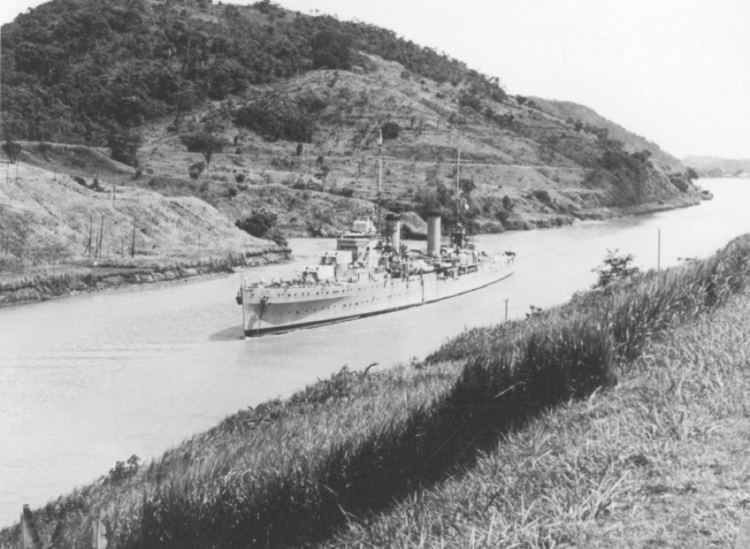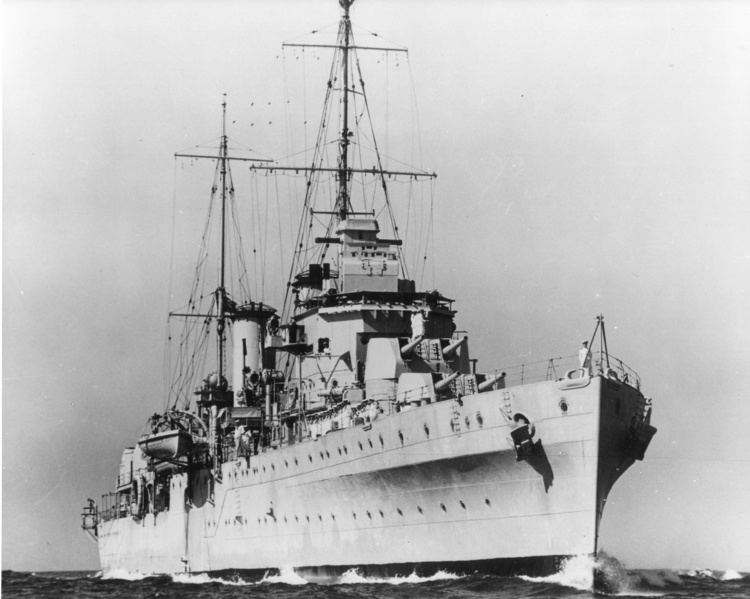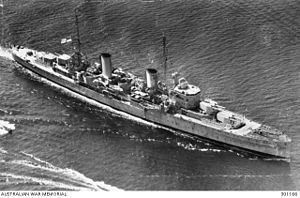Commissioned 15 June 1936 Launched 27 July 1934 Draft 5.97 m | Laid down 26 June 1933 Decommissioned 1939 Construction started 26 June 1933 Length 171 m | |
 | ||
Builder Portsmouth Naval Dockyard | ||
Hmas perth d29
HMAS Perth was a modified Leander-class light cruiser operated by the Royal Australian Navy (RAN) during the early part of World War II. She was constructed for the Royal Navy, where she was commissioned as HMS Amphion in 1936. After several years on the North America and West Indies Station, the cruiser was transferred to the RAN in 1939 and recommissioned as HMAS Perth.
Contents
- Hmas perth d29
- Design and construction
- Royal Navy service
- Australian acquisition
- World War II
- Loss
- Unauthorised salvage
- Legacy
- References

At the start of World War II, Perth was used to patrol Western Atlantic and then Australian waters, before she was sent to the Mediterranean Sea at the end of 1940. There, Perth was involved in the Battle of Greece and the Battle of Crete, and the Syria-Lebanon Campaign before returning to Australian waters in late 1941.

In February 1942, Perth survived the Allied defeat at the Battle of the Java Sea, only then to be torpedoed and sunk by the Imperial Japanese Navy at the Battle of Sunda Strait. Of the 681 sailors aboard, 353 were killed in battle. All but four of the 328 survivors were captured as prisoners of war: 106 died in captivity, and the surviving 218 were returned home to Australia after the war.

In late 2013, divers found that the wreck of Perth had been partially stripped by Indonesian marine salvagers.
Design and construction

The ship was one of three Modified Leander-class light cruisers constructed for the Royal Navy. She had a displacement of 6,830 tons, with a length overall of 562 feet 3.875 inches (171.39603 m), a length between perpendiculars of 530 feet (160 m), a beam of 56 feet 8 inches (17.27 m), and a draught of 19 feet 7 inches (5.97 m). The main difference to the previous five Leanders was that the newer ships had their machinery and propulsion equipment organised in two self-contained units (two Parsons geared turbines and two Admiralty 3-drum boilers in each machinery space), allowing the ship to continue operating if one set was damaged. The two exhaust funnels, one for each machinery space, gave the modified ships a different profile from the early Leanders, which had a single funnel. To cover the separate machinery spaces, the side armour was extended from 84 to 141 feet (26 to 43 m), negating the weight reduction created by the separation. The machinery spaces produced 72,000 shaft horsepower (54,000 kW) for the four propellers, and could drive the ship to a maximum speed of 31.7 knots (58.7 km/h; 36.5 mph). At top speed, the cruiser could travel 1,780 nautical miles (3,300 km; 2,050 mi), while the more economical speed of 22.7 knots (42.0 km/h; 26.1 mph) produced a maximum range of 6,060 nautical miles (11,220 km; 6,970 mi).
The Leanders' main armament was eight BL 6 inch Mk XXIII naval guns, fitted in four twin turrets. During design, it was planned to modify the foremost and aftmost 6-inch turrets to be fitted with three guns instead of two, but this plan was cancelled when it was determined that the required alterations would cause several negative side effects, such as reducing the cruiser's top speed and causing problems with her effective fire control.
Her secondary armament consisted of four 4-inch Mk XVI guns at first, but these were later upgraded to four twin mounts. For close-in defence, the ship was fitted with twelve 50 calibre machine guns in three quadruple mounts, and ten .303-inch machine guns, and a mixture of Lewis Guns and Vickers machine guns.
She was also armed with eight Mark VII 21-inch torpedo tubes in two quadruple mounts. The ship carried an amphibious aircraft (initially a Supermarine Seagull V, later a Supermarine Walrus) on a catapult. On entry into Australian service, the ship's company stood at 646 (35 officers and 611 sailors), but by the time of her loss, 681 were aboard: 671 naval personnel, six Royal Australian Air Force (RAAF) personnel, and four civilian canteen staff members.
This cruiser was laid down as HMS Amphion for the Royal Navy at Portsmouth Dockyard on 26 June 1933. She was launched by the Marchioness of Titchfield on 27 July 1934, commissioned into the Royal Navy on 15 June 1936, and completed on 6 July 1936.
Royal Navy service
During her Royal Navy career, Amphion saw service in the Caribbean Sea, the Atlantic Ocean, and the Pacific Ocean as part of the North America and West Indies Station. The cruiser also saw service as flagship of the Africa Station.
Australian acquisition
In 1939, Amphion was sold to the RAN: she was renamed HMAS Perth on 10 July 1939 by Princess Marina, Duchess of Kent, and was commissioned into service in the RAN on 29 June 1939. Perth was the last cruiser-type warship ever acquired by the RAN.
Most of the ship's company departed Australia in May 1939 aboard SS Autolycus: the enlisted men had to live and sleep in the ship's livestock holds. In early August, while en route to Australia, Perth was used to represent her nation at the 1939 New York World's Fair. While at New York City, there was a minor "mutiny" aboard. The instigation was orders that sailors ashore for leave would have to return to the ship at 18:00 and change from white uniforms to blue uniforms, although the overall treatment of the sailors by the officers had been an issue since the cruiser was taken over by the RAN. Over 60 sailors gathered on the ship's foredeck, where they were confronted by officers with sidearms (the first time RAN officers had been armed to deal with a mutiny) and were ordered below decks, but they refused. The warship's commanding officer, Captain Harold Farncomb, next approached the sailors and informed them that if they did not follow orders to disperse, he would treat their actions as a mutiny. The standoff could be seen from the wharfside, and a heavily armed force from the New York City Police Department was dispatched, but did not intervene. Farncomb successfully defused the situation by making the offer that any sailor wanting to wear blue uniform all day ashore could do so after asking permission; an offer taken up by almost every sailor taking shore leave.
World War II
While still en route to Australia, Perth was steaming off the coast of Venezuela when World War II broke out. As she was initially the only British Commonwealth warship in the Caribbean and western Atlantic, the cruiser began searching the region for German shipping. Perth did not leave the area until March 1940, sailing via the Panama Canal to reach Australian waters for the first time on 31 March. On arrival, Perth was assigned to convoy escort duty and patrols along the Australian coasts. These continued through November 1940, when she was sent to the Mediterranean Sea to relieve sister ship Sydney. Perth reached Alexandria, Egypt on 24 December, and she was assigned to the 7th Cruiser Squadron.
During January 1941, Perth carried out patrols of the Aegean Sea, and she supported the convoys to Malta. Perth survived air attacks on several occasions. February saw the cruiser patrolling around Greece and Crete, and then during March, she supported the Allied reinforcement of Greece by transporting soldiers from Alexandria, Egypt, to Piraeus.
On the night of 28–29 March, Perth played a major role in the Battle of Cape Matapan. The cruiser was involved in the evacuation of Allied troops from Greece in April. The cruiser was also involved in the Battle of Crete during April and May, and she was bombed on 30 May, with four of her sailors and nine of the 1,188 embarked soldiers killed when a bomb exploded in the "A" boiler room.
During June and July, Perth fought against Vichy French forces in Syria, and on one occasion, she avoided a friendly fire attack by Allied bombers. Perth was relieved by sister ship Hobart, and she returned to Australia for overhaul and upgrades to her anti-aircraft armament in August. After completion, Perth and the heavy cruiser Canberra steamed on 12 December 1941 from Sydney to Brisbane. Three days later, they met with the light cruiser HMNZS Achilles, and formed up as the heavy escort for the Pensacola Convoy. Perth continued convoy escort duties in home waters until the end of January 1942.
Perth was scheduled to remain in eastern home waters within the Anzac Area while HMAS Canberra underwent refit. The War Cabinet agreed to meet a request by the United States for deployment of Perth to the American-British-Dutch-Australian (ABDA) Area immediately and, in doing so, escort a convoy proceeding to ABDA. On 31 January 1942 Perth sailed from Sydney, reaching Fremantle on 10 February and on 15 February, relieved HMAS Adelaide as ocean escort for the convoy of four empty oil tankers and two cargo vessels (designated Convoy MS4) on a mission to claim as much oil from the Netherlands East Indies as possible before the Japanese invaded. After Singapore was captured (endangering the destination port of Palembang), all but Perth and the cargo vessel 's Jacob were ordered to return to Fremantle. Although joined en route by the Dutch ships Swartenhondt and Karsik, the operation was cancelled on 21 February, when the ships were 600 nautical miles (1,100 km; 690 mi) from Sunda Strait. Perth escorted the three other vessels back to within 700 nautical miles (1,300 km; 810 mi) of Fremantle before turning north to join the ABDA force. She arrived at Tanjong Priok on 24 February, in the middle of a Japanese air raid.
Perth then proceeded the next day, in company with HM Ships Exeter, Jupiter, Electra and Encounter, to Surabaya, where they met the ABDA fleet under Rear-Admiral Doorman. On receiving reports that a Japanese convoy of eight cruisers, twelve destroyers, and thirty transports was heading for Surabaya, the ABDA ships sailed to meet them. The Japanese ships were located on the afternoon of 27 February, and the Allied ships opened fire, with Perth setting a Japanese cruiser on fire with her second salvo. Later in the engagement, the Australian cruiser successfully fired on a Japanese destroyer. The forces broke apart after the British cruiser HMS Exeter was disabled, then later reengaged; during this, the Dutch cruisers De Ruyter and Java were torpedoed and sunk. Perth and the United States cruiser USS Houston were the only large Allied ships to survive the Battle of the Java Sea, and retreated to Tanjong Priok, where they arrived on 28 February. The two ships attempted to resupply, but fuel shortages meant that Perth took on only half her normal fuel capacity, and a lack of shells left the cruisers with what little ammunition was left over from the previous day. Perth, Houston, and the Dutch destroyer Evertsen were ordered to sail for Tjilatjap via the Sunda Strait.
Loss
Perth and Houston sailed at 19:00 (Evertsen was delayed), with Perth leading. The Allies believed that Sunda Strait was free of enemy vessels, but a large Japanese force had assembled at Bantam Bay. At 23:06, the two cruisers were off St. Nicholas Point when lookouts on Perth sighted an unidentified ship; when it was realised that she was a Japanese destroyer, Perth engaged. However, as this happened, multiple Japanese warships appeared and surrounded the two Allied ships.
At midnight, with ammunition running low, Captain Hector Waller ordered his ship to try to force a way through. Just as Perth settled on a new heading, four Japanese torpedoes hit the cruiser in the space of a few minutes. The first hit on the starboard side and damaged the forward engine room, the second caused a hull breach near the bridge, the third impacted in the starboard aft area, and the fourth struck on the port side.
Waller gave the order to abandon ship after the second torpedo impact. After some further close-range fire from the destroyers, Perth heeled to port and sank at 00:25 on 1 March 1942, with 353 killed: 342 RAN (including Waller), five Royal Navy, three Royal Australian Air Force, three civilian canteen workers, and the ship's mascot - a black cat called Red Lead. Houston was torpedoed and sank about 20 minutes later. Of the 328 survivors, four died after reaching shore, while the rest were captured as prisoners of war. 106 died during their internment: 105 naval and 1 RAAF, including 38 killed by Allied attacks on Japanese "hell ships". The surviving 218 were repatriated after the war.
Unauthorised salvage
In late 2013, divers found that the wreck of Perth was being stripped by Indonesian marine salvagers. Reports in September indicated that crane-equipped barges had stripped off most of the wreck's superstructure, forward turrets, and forward decking, and that explosives have been used to break the ship up for easier recovery. These actions have compromised the structural integrity of the wreck site, and have potentially exposed live munitions and oil tanks. Perth's wreck is not protected as a war grave, either through the UNESCO Convention on the Protection of the Underwater Cultural Heritage (Australia and Indonesia are not signatories to the treaty) or through legislation in either nation. The stripping of Perth's wreck was not publicly reported until December 2013; the Australian Broadcasting Corporation speculated that the government departments made aware of the issue tried to keep it under wraps to avoid further deteriorating relations between Australia and Indonesia, particularly following the Australia–Indonesia spying scandal.
In October 2015, United States Navy and Indonesian Navy divers embarked aboard USNS Safeguard undertook a nine-day survey of Perth and Houston. Divers documented the condition of the two shipwrecks, and identified signs of unauthorised salvage. The operation was a prelude to a conference in Jakarta on preserving and preventing the unauthorised salvage of wartime shipwrecks in the Java Sea.
Legacy
The cruiser's wartime service was later recognised with the battle honours "Atlantic 1939", "Malta Convoys 1941", "Matapan 1941", "Greece 1941", "Crete 1941", "Mediterranean 1941", "Pacific 1941–42", and "Sunda Strait 1942".
The HMAS Perth Memorial Regatta is held annually by the Nedlands Yacht Club, Perth, in honour of Waller, the crew, and the ship. The original ships' bells of the cruiser Perth and the Cold War-era destroyer of the same name are displayed at the Perth Town Hall. There is a memorial plaque in St John's Anglican Church, King's Square, Fremantle, and a memorial service is held annually in the church in late February.
